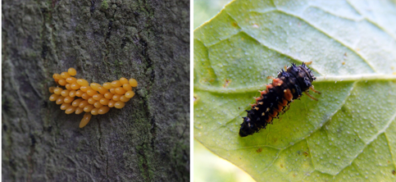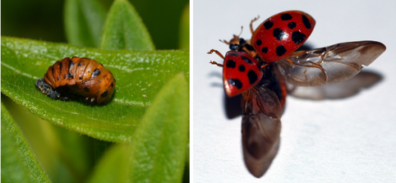Dear Rachel,
Every spring, I see spiny bugs that look like tiny alligators. They spend all day chomping up other insects outside my window.
I asked my friend Rich Zack about them. He’s an insect scientist at Washington State University.
He told me those spiky gobblers are immature ladybugs.
The ladybug life cycle includes complete metamorphosis. They undergo big body changes to become adults. An insect that does that is holometabolous.
“Millions of years ago, holometabolous insects split up their duties between the immatures and the adults,” Zack said. “An immature’s job is to feed. An adult’s job is to mate.”
There are four stages in this life cycle: egg, larva, pupa and adult.

Here are ladybug eggs on tree bark. We always write “ladybug” as one word because they’re not part of the true bug family. They’re beetles. You can also call them “lady beetles.” Bjorn S/Wiki Commons CC-BY-SA 2.0, Supportstorm/Wiki Commons
A ladybug starts out as an egg. They’re yellow or orange. They look like fat grains of rice. You might find them on the underside of leaves.
After a few days, the eggs hatch. A spiny larva comes out. Its job is to eat and grow.
First, it chows down on extra eggs its mother left behind. A particularly peckish larva might also eat its siblings—especially the small or slow ones. Then it starts snacking on nearby soft-bodied insects.
As it grows, its tough outer skin, or cuticle, gets too tight. The larva pops the skin open and climbs out. It has a new, bigger cuticle ready to expand and harden to fit its body.
The larva will molt like this a few times. The time between molts is called an instar.

Inside the pupal case, the ladybug doesn’t move or eat. It’s busy transforming. An adult ladybug will eventually emerge. It will have soft membranous wings tucked under a pair of hard wing coverings called elytra—like all beetles do. Andy Reago & Chrissy McClarren/Wiki Commons CC-BY-SA 2.0, Clinton & Charles Robertson/Wiki Commons CC-BY-SA 2.0
After a few weeks, a ladybug larva is ready to transform into an adult. It sheds its cuticle one last time. But this time it stays inside. That’s now a pupal case.
The pupal case is hard. It sticks firmly to a leaf or other surface. Inside, the larva’s body breaks down. It reorganizes into an adult body.
After about a week, an adult ladybug comes out.

Zack said about 60% of insects are holometabolous. About 30-35% are hemimetabolous. You can remember those terms because “holo” sounds like “whole” change and “hemi” sounds like “semi” change. Image: Sci Rep 11, 10313 (2021), I. Peralta-Maraver under CC BY open access copyright, based on Belles, cropped by Dr. Universe
Zack told me that most insects go through a big change like that. About a third of insects go through a partial metamorphosis instead. Those insects are hemimetabolous.
They have three stages: egg, nymph and adult.
Since they don’t undergo a big change, the immature nymphs look a lot like the adults. They’re just missing wings and working reproductive parts. They’ll get those at their final molt.
The least common life cycle has no metamorphosis at all. Those insects are ametabolous. The juveniles look exactly like the adult, just smaller. They never get wings.
Ametabolous insects are so well-adapted that they haven’t changed much for millions of years. The ancestors of all insects were ametabolous.
Complete metamorphosis—like ladybugs undergo—is the newest insect life cycle.
It’s possible it evolved so the juveniles and adults don’t compete. Or maybe it happened that way to make better wings. But it’s still a mystery. It’s wild that so many insects break down and reorganize their bodies just to grow up.
“It’s so complicated and so vulnerable,” Zack said. “We see changes in other animals but nothing like this. It’s just amazing.”
You really can’t beetle an awesome adaptation like that.
Sincerely,
Dr. Universe